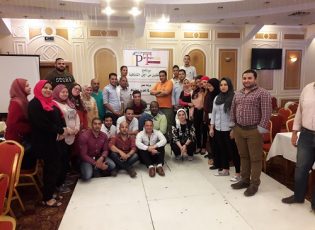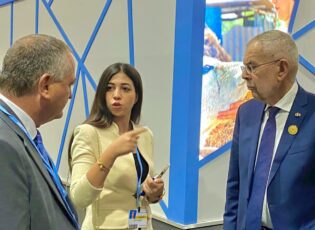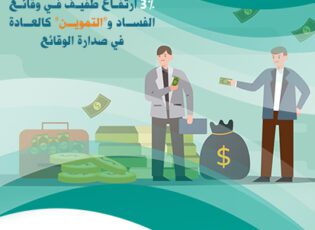Transparency and integrity in the Arab region.
"First annual report"
The Arab Pilot Index for "Systems to Prevent Corruption and Enhance Transparency"
2018
Introduction and methodological framework
The phenomenon of corruption is a harmful epidemic that undermines the rule of law and impedes the ability of governments to provide basic services to their people, obstructs development projects, violates human rights, and under which crime and terrorism flourish, which leads to a deterioration in the standard of human life and brings instability, insecurity and widespread injustice. The countries of the world have realized the grave dangers resulting from corruption, as it is a serious crime that undermines the rule of law, impedes development, spreads poverty and ignorance, and prevents rights from reaching their owners..
Researchers agree that corruption has extended over time and has its extensions to include all countries of the world without exception, but the most important development is the unprecedented growth of corruption and its implications, which have become the interest of many international, regional and national organizations that have taken upon themselves to monitor the phenomenon in all countries of the world.
The phenomenon of corruption has gained the attention of researchers and academics in various countries of the world and many countries of the world have begun to devote their efforts by establishing local and international bodies and organizations specialized in combating corruption and have begun to develop strategies and policies that work to provide solutions to this problem, reduce its effects and limit its repercussions. Transparency International, organization UNDP And the Office on Drug Control of the United Nations, the World Trade Organization and the World Bank) and all of these organizations began to develop definitions of corruption in order to collect insights on the term corruption, and thus proceeded to develop indicators, policies and plans in order to measure the extent of corruption in various countries of the world and to develop appropriate solutions that are compatible with the environment and nature of each system Every society, and consequently, the phenomenon of corruption took more and more global attention to find appropriate solutions to this problem, which is exacerbated especially in the third world countries, including the Arab countries..
During the past seven years, the Arab region has been rippling with political and economic changes, and despite the different intensity, extent and nature of these changes from one country to another, they all had a wide impact on the existing structures in those countries, and led to radical transformations that cannot be easily overcome.
Conclusively, it can be said that the Arab world in 2010 is clearly different from the post-210 era, as a massive wave of popular protests erupted in a number of countries against the background of growing rates of political, financial and administrative corruption, human rights violations and the failure of economic and social policies in quite a few Arab countries, and these protests have led to a change in the ruling elites in some countries, while other countries have entered into a fierce civil and sectarian wars that have not yet escaped them, while those protests have pushed towards tangible partial changes in the nature of the existing political systems in some other countries. As well as the tendency of other countries to adopt agendas that carry some reform features, especially the end of corruption cases.
At the present moment, it can be said that there are three Arab countries, namely Syria, Libya and Yemen that have failed to fully manage the democratic transition process, and are still mired in civil strife driven by the external agendas of some regional powers, while countries such as Egypt, Tunisia, Jordan, Morocco and Lebanon have managed to restore stability. But with an extremely harsh economic and security bill, while some countries maintained their cohesion due to their successful domestic and foreign policies (such as the UAE, Oman and Kuwait), countries such as Saudi Arabia and Bahrain benefited from what happened and adopted reform agendas that are still ongoing.
In general, and as one of the negative side effects of these changes, terrorist groups and organizations expanded and tried to impose their agenda and dealt - and are still directing - painful blows that threaten stability, security and development in many Arab countries, groups that seemed to be driven and supported by forces in the region that find in these groups a way to extend Its political influence is in contravention of relevant international and ethical standards, and these forces have used their monetary savings to provide safe havens, political umbrellas and media platforms for terrorist groups.
Issues of integrity, transparency and anti-corruption were at the forefront of the issues raised by the wave of protests, and by extension the policies and legislations of the ruling systems reflected in the post-protests phase, which called the Partners Foundation for Transparency to initiate the issuance of an annual Arab report that discusses this issue and provides information and data to those interested and concerned. It helps them paint a picture of the nature of the situations related to this issue, and it helps policy makers and policymakers in the Arab countries to adopt approaches that promote integrity, transparency, accountability and anti-corruption practices.
The first Arab report focuses mainly on monitoring the current situation, analyzing the legislative and institutional structures related to combating corruption and promoting transparency and integrity, evaluating the position of the Arab countries towards the relevant international agreements, clarifying the general features of these phenomena in the different Arab countries, and revealing for the first time a proposed experimental indicator To assess some aspects of transparency and integrity in the Arab region through the “proposed Arab index for the prevention of corruption system”
The proposed Arab index for the prevention of corruption system
One of the biggest challenges associated with monitoring and following up the phenomenon of corruption and evaluating the practices of transparency and integrity in the Arab region is the absence of measurement mechanisms and methodological tools through which we can accurately describe the extent of this phenomenon, and evaluate the efficiency and effectiveness of national systems of integrity, transparency and anti-corruption.
Despite the appreciated efforts made by some state institutions - specifically, Transparency International - it is exposed to multiple methodological challenges, and it cannot be assured that it accurately and categorically reflects the level of integrity and transparency in different countries.
Most of the global and Arab measurement attempts depend on measuring the awareness of a sample of stakeholders of the extent of corruption and its spread in a particular country, which is a method of measurement that appears superficial and does not reflect depth in studying and analyzing the phenomenon, in addition to the lack of available information on the phenomenon in general that is very difficult to measure.
In this regard, the Partners for Transparency Foundation begins with this report in an attempt to open a discussion on experimental indicators to measure corruption phenomena and practices of transparency and integrity in the Arab region, and we present in this report a proposed pilot indicator that measures only the "corruption prevention system"
Measurement methodology
The proposed index consists of 12 axes that reflect the constitutional, legal and institutional dimensions related to preventing corruption in each country, represented in: -
- Ratification of the United Nations Convention against Corruption
- Ratification of the Arab Convention against Corruption
- The existence of an elected parliament, direct free election
- The constitutional and legal text on the right of parliament to monitor and hold the executive branch accountable
- Existence of regulatory agencies concerned with combating corruption and promoting transparency
- The constitutional and legal text on the independence of the regulatory agencies
- The constitutional and legal text providing for the right to access information
- The constitutional and legal text on the independence of judicial institutions
- The constitutional and legal text on the freedom of action of civil society organizations
- The constitutional and legal text to prevent conflicts of interest
- The constitutional and legal text on protecting whistleblowers and witnesses in corruption crimes
- The constitutional and legal text on media freedom
The index measures the availability of each of these dimensions according to four estimates, which are: Not available and according to which the state obtains a degree of zero, is available in a limited degree, according to which the state obtains one degree, is available in a medium degree, and according to which the state obtains two degrees, and is widely available and according to which the state obtains Three degrees.
Then the state’s scores are collected in all axes to give a general assessment of the availability of a “national system for the prevention of corruption,” and then the minimum and upper scores of the scale ranges from zero to 36.
It should be noted that this measure does not measure the effectiveness of the national integrity system, nor does it evaluate corruption rates in a country, but only measures the availability of legislative and institutional requirements to combat corruption and enhance transparency and integrity, and partners for transparency will work in the future to revise this indicator and add other indicators. To reach a comprehensive indicator of the phenomenon of corruption and the effectiveness of integrity and transparency systems in the Arab region.
During the experimental application of the index, we adopted a methodology that combines an analysis of the constitutional, legal and institutional systems on the one hand, and the evaluation of experts on the other hand.
As the constitutional and legal systems, the available literature and the institutional reality in each country were reviewed, as well as a survey and evaluation of experts, researchers and interested parties, on the basis of that a score was given for the country in each axis of the index.
Transparency and integrity in the Arab region !!!
Short link: https://pfort.org/en/?p=2888









